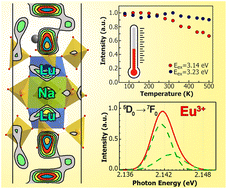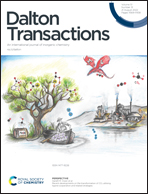NASICON-type Na3.6Lu1.8−x(PO4)3:xEu3+ phosphors: structure and luminescence†
Abstract
Na3.6Lu1.8−x(PO4)3:xEu3+ phosphors were synthesized by a high-temperature solid-state reaction. A powder X-ray diffraction study revealed that homogeneous solid solutions with a NASICON-type structure were formed at 0 ≤ x ≤ 0.7. The Na3.6Lu1.8(PO4)3 structure was refined from the powder X-ray diffraction data and the cation distribution in the lattice sites of the NASICON-type structure was revealed. The refinement indicates structural disorder caused by the displacement of a part of Lu cations along the c axis inside the (Lu/Na)O6 octahedra that is confirmed by the broadened emission lines of Eu3+, which substitutes Lu cations. The highest Eu3+ luminescence intensity is found in Na3.6Lu1.8−x(PO4)3:xEu3+ for x = 0.5, whereas a further increase of the Eu3+ content leads to concentration quenching that is shown to occur due to the dipole–dipole interaction. An enhanced temperature stability of the Eu3+ emission was observed at the excitation energy of 3.23 eV. At this excitation energy, thermal quenching of the emission caused by the 7F0 → 5L7 transitions is compensated by the intensity increase of the emission related to the 7F1 → 5GJ transitions, which occurs due to the increase of the 7F1 level population, induced by a temperature rise.



 Please wait while we load your content...
Please wait while we load your content...